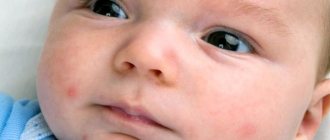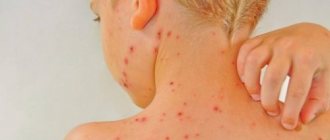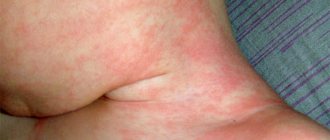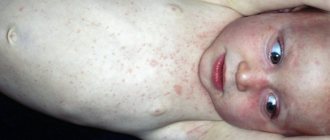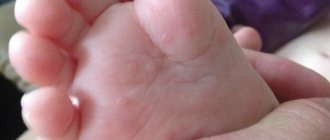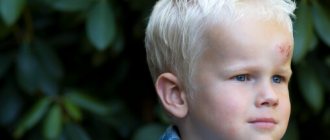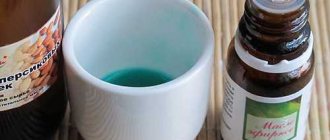Herpes is the collective name for a number of viral diseases, the causative agents of which are various types of herpes virus. At the present stage, science identifies as many as eight of its varieties.
Both adults and children of all ages suffer from this pathology. As for children, the source of their infection most often is parents or other children, especially in closed groups such as kindergartens and schools.
Primary herpes most often occurs in children , and in the first years this pathology practically does not occur in them, since every child receives immunity from it through mother’s milk. In the third–fourth year of life, the frequency of infection begins to increase steadily, and 60–80% of five-year-old children already have antibodies to the herpes virus.
general information
Herpes on the face of a child - photo:
Herpes is a disease of viral origin, characterized by the appearance of blisters on the body and mucous membranes of a person. The blisters contain serous fluid, which comes out as the disease progresses. The remaining wound heals within a few days.
The infection may affect the child's face. Most often this happens in children 2-5 years old. The disease can be accompanied by one or several bubbles. Herpes in most cases occurs on the lips, chin, and cheeks.
The virus can remain in the child’s body for quite a long time, but still not make itself known. It only appears when the immune system is weakened.
How to treat?
Treatment of herpetic dermatitis is carried out using external agents. How to treat herpes in a baby should be determined by a specialist. The doctor not only makes a diagnosis, but also determines whether it will be enough to use exclusively external agents for recovery.
The most effective treatment will be if an integrated approach is implemented: drugs of not only local, but also systemic action are used.
It is not recommended to use brilliant green to treat herpes on the face in children. The solution has no effect on the virus itself, but can cause skin burns in the baby.
To prevent further spread of the viral manifestation, it is necessary to treat the skin on the face with an antiseptic drug that does not contain alcohol. This can be hydrogen peroxide 3%, chlorhexidine.
For treatment, you can use folk remedies: tincture of calendula, chamomile. Their use will help avoid the formation of pustules. In order to avoid the appearance of crusts, the bubbles are lubricated with essential oils. This could be oil of oregano, ginger, lemon.
Ointments that can be used to treat herpetic dermatitis on a child’s face:
- Acyclovir and drugs containing the active substance of the same name. It is possible to use such drugs as: Zovirax, Virolex, Acyclostad. All these drugs have the same composition and do not differ in pharmacological action.
- Ointments with Penciclovir. This is Fenistil Pentsivir. The effect of the product is similar to ointments based on acyclovir.
- Viferon. Available in the form of a gel and ointment, it contains interferon. It is characterized by two actions at once: antiviral and immunomodulatory. Treatment with this drug is well tolerated even by young children. It can be used to eliminate herpetic rashes in children under one year of age and has no contraindications for use. The only limitation may be individual intolerance to the drug. Viferon is applied throughout the entire treatment period.
- Panavir, Viru-Merz. The active ingredient in these drugs is Tromantadine. It is advisable to use these drugs at the initial stage of the disease, before bubbles appear.
Where does it occur?
Doctors say that in children, herpes appears not only on the lips, but also on the cheeks, forehead, nose and even on the chin. Herpes can affect any part of the body and face.
Parents need to be very careful about their child's health. If blisters appear on the face, it is recommended to immediately consult a doctor to clarify the diagnosis .
Often, blisters on a child’s face are perceived by parents as manifestations of a cold .
They are in no hurry to take the baby to the doctor. Experts strongly recommend visiting the hospital to determine the disease.
Preventive actions
The virus is transmitted exclusively from person to person. Therefore, parents need to be careful: if the virus worsens in someone they know, do not allow the child to communicate with him. A healthy baby, even if infected, may not experience any reaction. It will appear only when the immune system is weakened.
This may happen in the following cases:
- ARVI;
- hypothermia;
- dysbacteriosis;
- poor nutrition;
- unorganized daily routine and lack of hardening.
Immunomodulatory drugs that can be used to strengthen the immune system include:
- Lycopid. The drug is given one tablet for 10 days.
- Derinat. It has no contraindications and is used to strengthen the immune system.
- Cycloferon. Can be prescribed to children over 4 years of age; use is possible only as prescribed by a doctor.
- Viferon. Used to treat young children. The drug is available in suppositories. Duration of therapy is 1 week.
When herpetic dermatitis appears on a child’s face, urgent measures should be taken. To determine a treatment regimen, you should contact an infectious disease specialist or pediatrician.
4.2 / 5 ( 5 votes)
What is it caused by?
The disease is caused by the Herpes zoster virus. This pathogen enters the body in various ways. This is usually close contact with a person who is already infected . Parents can transmit the virus to their child by kissing.
In everyday situations, the virus can be transmitted from one person to another: through household objects that contain at least a drop of saliva from an infected person. We are talking about dishes and hygiene products.
Infection occurs instantly. As soon as the virus enters the body, it begins to actively affect the body.
Symptoms of herpes on fingers
The favorite localization of the virus is herpes on the fingers (photo 2). The palms, hands and wrists are affected less often, but the fingers, due to their thin and delicate skin, become targets for herpetic infection. Herpes usually appears on the fingers after a decrease in immunity. It is enough for the virus to settle here once, and with any weakening of the body’s defenses, the fingers begin to suffer from manifestations of the disease.
At the very beginning of the development of the infection, the fingers begin to bother the patient with causeless itching, which cannot be eliminated. Herpes on the fingers of a child begins with restlessness, scratching of the fingers and constant burning on the sides. After some time, at the site of itching, you can notice a small pinkish swelling that has jagged edges - this is a herpetic rash.
Often, herpes zoster on the hand can involve several fingers, located on the surface of the skin in the shape of a ring. Most often, the fingers are affected on the sides, because here the skin is thinnest. Herpes blisters quickly appear in small numbers, go through all stages of their development, and even after the disease is completely cured, there are no traces of their presence left.
Causes and development factors
The causes of this disease include:
- Infection . Penetration of the virus into the child’s body.
- Hypothermia . It negatively affects the baby’s immunity and leads to herpes.
- A recent infectious disease , cold or flu. The body does not have time to recover, and this is a favorable environment for the herpes virus.
- Stress . If a child often finds himself in stressful situations, this negatively affects the immune system and leads to the development of herpes.
- Lack of vitamins . If there is a lack of substances beneficial to the body, herpes may appear.
Risk factors include overheating, prolonged contact with sick people, and vitamin deficiency. Herpes often appears in children who often catch colds. Doctors also consider children who have an allergic reaction to be at risk.
You can learn about methods for preventing hypervitaminosis in children from our article.
Prevention of herpes infection
If a herpes infection in a child recurs quite often, you should consult with an immunologist who can help correct or compensate for all defects in the patient’s body’s defense system.
It is not yet possible to completely get rid of the herpes virus that has infected a child’s body with the current level of medicine, and from time to time it causes a deterioration in the condition. Therefore, parents of a sick child must fully comply with all the doctor’s prescriptions, paying special attention to his personal hygiene, especially hand washing, providing individual soap, a washcloth and a towel. If herpes has caused the formation of ulcers on the oral mucosa, the baby should not be allowed to injure them.
In order to prevent a child from becoming infected with the herpes virus, you should explain to the child the need to strictly observe the rules of personal hygiene , not allow him to use the personal belongings of strangers, and not allow him to have contact with infected people. As for the immune system, it can be strengthened by proper nutrition, vitamin therapy in the fall and spring, and taking stimulants in the winter months. And if a flu epidemic occurs, then every child infected with herpes should be protected from infection, including by placing antiviral ointments in his nasal passages once or twice a day. And remember, prevention is always easier and cheaper than treatment.
Herpes in children
Symptoms and signs
Identifying herpes is quite simple. It has pronounced symptoms:
- The appearance of blisters on the face. They are small in size and filled with liquid inside.
- Itching and tingling. The baby complains of discomfort, tries to scratch, touch the sore spot.
- Swelling . The area around the lesion becomes hard and swollen.
- Temperature increase . The child has a fever. This happens especially often in the first few days of illness.
- Weakness , lethargy. The baby does not play, lies down a lot, and gets tired quickly.
- Loss of appetite . The child refuses to eat and does not feel hungry.
- Paleness . Children may have pale skin. He looks unhealthy.
Manifestations of herpes in the nose of a child and treatment methods
- Symptoms of herpes in the nose in children
- Causes
- How and with what to treat
Herpes in the nose of a child is not very common, since the rash caused by this virus is often localized on the lips. In fact, this sign of herpes appears at the site of its activation, that is, if it gets on the nasal mucosa, when the disease recurs, a rash appears in this area.
Herpes in the nose of a child is not very common, since the rash caused by this virus is often localized on the lips.
Symptoms of herpes in the nose in children
When a rash first appears on the nasal mucosa and the skin around it, the patient may experience general symptoms. After the virus penetrates the tissues of the nasal mucosa and the incubation period is completed, patients begin to complain of:
- slight increase in body temperature;
- formation of bubbles with liquid;
- general deterioration of condition;
- redness of the mucous membranes;
- headaches;
- itching;
- burning.
When the disease relapses, in most cases there are no symptoms of general intoxication. In addition, in this case there is no increase in body temperature. When herpes in the nose recurs in children, it is much easier.
Both during primary infection and during exacerbation, the blisters that appear subsequently dry out, so the affected area of the skin and mucous membranes becomes covered with dark crusts.
If you use a handkerchief, there may be traces of blood on it. This is especially common if a patient who experiences severe itching and burning in the nose scratches the affected areas. Tearing off the crust located on the mucous membrane can provoke bleeding.
Complications from herpes in the nose in children are rare.
This disease carries a risk of self-infection, in which the infection spreads to other areas of the skin. In rare cases, herpes of the nasal mucosa can cause complications such as inflammation of the meninges, damage to the eyeballs, secondary infection and conjunctivitis.
Types and forms
The disease manifests itself in two forms:
- spicy _ A severe course of the disease is characteristic. There is more than one bubble, the temperature rises greatly. The face swells. The child cries and has problems falling asleep. No appetite, possible nausea;
- chronic _ Symptoms of the disease are mild. The temperature rises slightly and returns to normal almost immediately. There is one bubble, less often two. They pass quickly, the child feels well. Weakness, dizziness and swelling are not observed. The body quickly recovers.
Experts identify three types of disease in children:
- primary _ Appears in a child for the first time. A serious condition occurs because the child’s body has not produced antibodies. The severe condition lasts up to 2-3 weeks;
- recurrent . Reappears again. The child's condition cannot be called serious. There is no weakness or headache. The body has already produced antibodies and successfully fights the virus. The child recovers quickly: he recovers in 8-10 days;
- neonatal . Happens in newborns. Infection occurs during birth: the child passes through the mother's birth canal and becomes infected with the herpes virus.
Serious treatment and constant monitoring by a doctor are needed. The serious condition of a newborn lasts up to three weeks.
What does herpes look like on hands?
Herpes on the hands (see photo 1) is difficult to recognize - the surface of the skin in the most delicate places is covered with typical herpetic rashes. Herpes on a child’s hand can be initially confused with an allergy, but with the appearance of blisters the diagnosis becomes obvious. Herpes blisters appear both individually and in groups in certain places. Herpes on the skin of the hands begins with an itchy sensation, usually in the area of thinning skin.
The initial stage of herpes on the hands is, first of all, itching and redness on the surface of the skin. Herpes on the hands looks quite typical - itchy spots turn into blisters filled with liquid, they hurt and bother the person with any movement of the hands. Symptoms of herpes on the hands quickly worsen, the liquid inside the blisters becomes cloudy, then the blisters burst, leaving behind weeping sores. After some time they dry out and then peel off. Symptoms of herpes on the fingers usually go away within ten days.
Complications and consequences
If treatment is not started in time, complications may arise:
- Otitis . The disease can lead to ear diseases and hearing loss.
- Diseases of the cardiovascular system. Herpes leads to serious diseases that affect the heart and blood vessels, leading to serious conditions that are life-threatening.
- Meningitis . It occurs as a complication quite often.
- Diseases of the nervous system. Psychoses and neuroses in the child are possible. He becomes nervous and restless.
- Digestive disorders . The child may suffer from frequent gastrointestinal disorders.
With timely treatment, negative consequences can be avoided.
How to treat intestinal flu in children? Find out the answer right now.
Etiology
Rashes on the face can occur due to 3 types of viruses: simple virus types 1 and 2, as well as chickenpox.
Virus particles penetrate most easily into loose, moist shells. Therefore, most often it penetrates through the lips. Virus particles that enter the body infect nerve cells and change cell chromosomes. After this, the body produces small numbers of viral cells throughout its life.
In response to such an invasion, antibodies are produced - this is how immunity to the virus appears. The infected cells produced are destroyed by the immune system, and there are no manifestations of the disease. However, when the immune system weakens, it cannot fight off infection.
Possible complications with herpes on the face:
- Otitis. There is a possibility of deterioration or complete loss of hearing.
- Damage to the cardiovascular system.
- Meningitis.
- Diseases of the nervous system.
- Pathologies of the digestive system.
Such consequences are possible if treatment measures are not taken in a timely manner.
Diagnostics
To diagnose the disease, you must consult a doctor. A specialist uses the following methods to determine the disease:
- Examination of the patient. The doctor examines the lesion.
- Blood analysis . Allows you to identify the virus.
- A smear of the affected area. The doctor carefully takes a smear of the painful area, and the resulting material is studied in the laboratory. Allows you to identify the disease extremely quickly.
The above methods are enough to confirm or deny the presence of herpes.
Causes
This infection is caused by HSV - herpes simplex virus, usually type 1. The disease can be localized on the skin and nasal mucosa, in the area of the nasolabial triangle.
Once it enters the body, the virus settles there forever, localizing in the neural nodes (ganglia).
In a person with strong immunity, the infection is blocked by specific antibodies, then the virus does not manifest itself. But the constant threat of relapse is inherent in people with weak immune systems.
How can infection occur? The virus is transmitted through contact with a patient or through the use of his personal belongings. It also enters the body through airborne droplets: if you are near a sneezing and coughing carrier of the virus.
After treatment of the primary infection, herpes on the nose goes into remission. And periodic relapses of the disease are caused by provoking factors:
- weakened immunity;
- acute respiratory diseases;
- hypothermia;
- chronic fatigue;
- frequent use of antibiotics.
The psychosomatics of the disease also associates the occurrence of herpes with stressful situations, which are a serious provoking factor.
Treatment
How to treat a child? Pharmacy, folk remedies and injections are used to treat a child.
Preparations, ointments, creams
First, doctors prescribe drugs that fight the herpes virus:
- Acyclovir;
- Valtrex;
- Famciclovir.
These medications are made in the form of tablets and effectively fight the virus and promote recovery . Take one tablet 2-3 times a day between meals. You can take these medications only for the first five days to avoid overdose.
It is recommended to take medications that are aimed not only at fighting the virus, but also at strengthening the immune system:
- Kagocel;
- Amiksin.
The drugs effectively increase the child’s immunity and lead to recovery. You should take them for the first 3-5 days, one tablet twice a day.
Among the ointments there are:
- Zovirax;
- Citivir;
- Virolex.
These remedies effectively relieve itching and burning, and eliminate swelling. They are applied to the affected area 2-3 times a day.
the following cream during treatment :
- Vectavir;
- Vivorax;
- Panavir.
Apply the cream to the affected area twice a day.
The components of these medications relieve itching and burning and lead to recovery. The child's swelling disappears, the wound heals quickly.
If a child has a high fever, it is recommended to give him the medicine Paracetamol. One tablet is enough to relieve fever. You should not take more than three tablets per day.
Recommendations for the treatment of sudden exanthema in children can be found on our website.
Injections
If herpes occurs frequently in a child, specialists prescribe injections. Before vaccination, the child is examined by a doctor and then carries out the procedure. Experts use the Vitagerpavac .
Injections are administered to produce antibodies and increase human immunity. Typically five injections are given at intervals of 8-10 days. A repeat injection session is carried out after 6 months.
Injections are performed only in a hospital by a doctor. It is prohibited to administer the medicine yourself by injection.
Are antibiotics needed?
Antibiotics are not prescribed for herpes, as they are useless . They cannot cure an infectious viral disease.
Will folk remedies help?
Folk remedies cannot eliminate the disease.
They do not fight the virus, but can relieve symptoms and alleviate the patient’s condition.
It is recommended to treat herpes with celandine juice . Fresh grass is crushed and juice is extracted from the pulp.
Soak a cotton pad in it and apply it to the affected area for 15 minutes. The medicine will alleviate the patient’s condition, eliminate swelling, itching and burning. The procedure is performed three times a day.
It is useful to use aloe juice. To do this, the plant leaf is washed and crushed. Juice is extracted from the pulp and the affected area is lubricated with it 3-4 times a day. The juice of this plant will speed up recovery.
will help relieve symptoms of the disease . A tablespoon of this product is dissolved in warm boiled water.
A cotton pad is soaked in this solution and applied to the painful area for 15 minutes. The procedure must be performed in the morning and evening.
Folk recipes
Treatment of viral diseases can additionally be carried out using traditional methods. The following medicinal herbs can be used to combat the herpes virus:
- series;
- celandine;
- sagebrush;
- calendula;
- oregano
Strong decoctions are prepared from these plants for external use. Take 3 tablespoons of any herb, fresh or dry, and pour boiling water over it and leave for 20 minutes.
Wipes are moistened in the resulting infusion and applied to the area of the rash 3-5 times a day. Such lotions eliminate itching and pain. They also have a slight antiviral effect, but their use alone is not enough for treatment.
The bubbles can be smeared with a cut aloe or Kalanchoe leaf. Applications with juice are made every 3 hours. This remedy is quite effective - after a day, the serous fluid flows out of the blisters, and the healing process begins.
You can use the properties of medicinal herbs to strengthen the immune system. For this purpose, use:
- Rhodiola rosea roots;
- rose hips and hawthorn fruits;
- St. John's wort;
- lure root.
Mix a tablespoon of all ingredients, add boiling water and leave in a thermos.
The decoction is given 30 minutes before meals, warm, in a third of a glass. It should be taken throughout the entire period of relapse, cold.
There is a significant difficulty in treating children - maintaining hygiene. Children forget that they should not touch the affected area. After contact with virus particles, they may not wash their hands when touching other parts of the body - therefore, the likelihood of spreading the virus is high.
How to take care of your face?
Doctors recommend protecting the child’s face from sunlight, as they can provoke an exacerbation of the disease. Symptoms may get worse.
You can touch the bubble with water, but only in moderation. Do not apply too hot or cold water to the wound.
You are allowed to wash your face very carefully , without strongly touching the affected area, since it can become covered with a crust and heal, and water will eliminate it and delay the healing process.
Dangers of the disease
In general, skin infections with the herpes simplex virus are not considered a particularly dangerous disease. Patients with normal immunity very rarely develop any complications and, in addition, the disease almost never develops in a severe form.
.
However, in the presence of immunodeficiency, the disease without adequate treatment may not subside and spread to surrounding tissues. In such patients, damage to internal organs, development of neuritis, and damage to the meninges are also possible, and therefore their disease must be monitored and managed by a doctor.
The main consequences of herpes simplex for the average person are as follows:
- Constant relapses with weakened immunity. They occur rarely; in many infected people they either do not appear at all or are asymptomatic. For this reason, many carriers of the herpes simplex virus are not aware of its presence in the body;
- The risk of bacterial complications and the development of superinfection with bacterial panaritium is highest when opening papules on your own (vesicles cannot be opened, pierced or tried to be removed in other ways in the hope of getting rid of them as quickly as possible);
- Possible infection of other parts of the body, in particular the genitals, skin or mucous membranes of the eyes.
The normal time frame for the completion of the disease and the complete shedding of crusts in place of the papules is 15-20 days. If the disease drags on, the affected area constantly increases, or ulcers appear, then you need to consult a doctor.
Note: herpes localized on the hands lasts about as long as the disease on the lips. With labial herpes, the process involves not so much the mucous membranes (which can quickly regenerate), but primarily the skin in the lip area, and therefore the healing process is no different from that for rashes on the arm.
Herpetic lesions of the hands during pregnancy do not pose a danger to the fetus, but in this case there is a slightly increased risk of self-infection with the genital form of the disease with subsequent difficulties in managing pregnancy. In addition, it is important to know for what reasons the disease developed during this period, since it is the factors that contribute to the development of relapse that can be more dangerous for a pregnant woman than the herpetic infection itself.
Also during this period, illiterate treatment of the disease, not only with pills, but also with some folk remedies, can pose a significant danger to the fetus.
